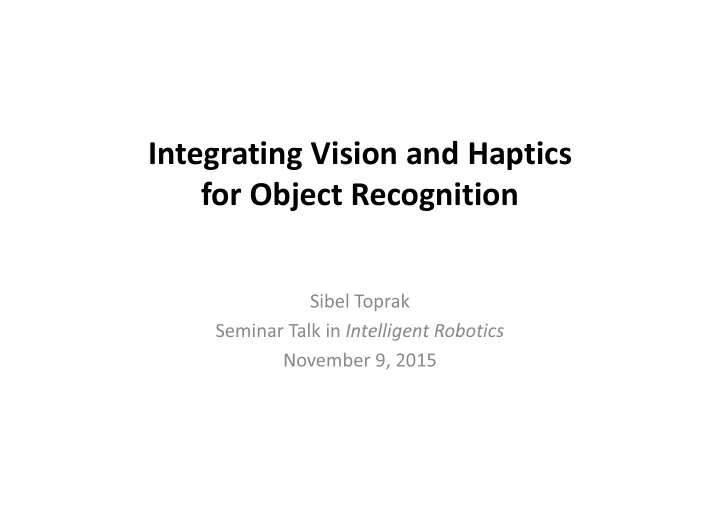

Integrating Vision and Haptics for Object Recognition Sibel Toprak Seminar Talk in Intelligent Robotics November 9, 2015
Motivation • Robust object recognition capabilities required in most robot applications However: • Object recognition based on vision alone not reliable enough in most cases http://japan-wa.de/roboter-hotel/ 2
Visual Object Recognition Problem 1: Problem 2: Not all discerning features are visual! The sight is not always perfect! ‟Robot, get me the full bottle!” Occlusions and darkness in the Which one is it? scene, objects that are particularly visually complex, … https://www.sigg.com, http://www.asdirect.fr/images/produits/p6057-2.jpg 3
Haptic Exploration Procedures [Lederman and Klatzky, 2009; 1987] 4
Haptic Object Recognition Submodalities: Advantages for : Object Learning More rich and distinctive characterization of objects during exploration Object Manipulation Learning how to interact with objects based on the received tactile and kinesthetic haptic feedback (e.g. texture and weight of objects) http://de.123rf.com/photo_3716245_kleines-kind-mit-apfel--8-isoliert-auf-wei.html 5
Question ⁞ ⁞ Visual Input Classification Integration Strategies? Output ⁞ ⁞ Haptic Input 6
Question ⁞ Not covered here! ⁞ Visual Input Weighting Neural Network Classification Architecture Output ⁞ ⁞ Haptic Input Level of Integration 7
General Approach Validate the different integration strategies using neuroscientific evidence https://commons.wikimedia.org/wiki/File:Human-brain.SVG 8
Sensory-Level Integration ⁞ Insert any established ⁞ Artificial Neural Network Visual Input Architecture here Classification Output e.g. Deep Learning Architectures, ⁞ Echo State Network, … ⁞ Haptic Input 9
Issues • No modularity ⇒ Difficult reuse of processing results for other tasks ⇒ Not much insight into what is actually learned ⇒ Waste of computational effort • Neuroscientific counterevidence ⇒ Next slide 10
Cortical Sensory Areas in the Brain http://www.d.umn.edu/~jfitzake/Lectures/DMED/SensoryPhysiology/GeneralPrinciples/CodingTheories.html 11
Decision-Level Integration ⁞ Visual Object Recognition Module ⁞ Visual Input Decision-Level Classification Integration Output Module ⁞ Haptic Object Recognition Module ⁞ Haptic Input 12
Issues • Dominance of vision over haptics ⇒ Result of haptic part might not be needed ⇒ Waste of computational effort • Recent neuroscientific counterevidence ⇒ Next slides 13
Somatosensory Cortex Brodmann Areas Sensory Hierarchical Homunculus processing of somatosensory information Somatotopic organization https://classconnection.s3.amazonaws.com/698/flashcards/723698/png/untitled1319491580334.png 14
Visual Cortex Extrastriate Areas (V2-V5) Striate Area (V1) Retinotopic organization Hierarchical processing of visual information http://people.brandeis.edu/~teuber/Vision.pdf 15
Ventral and Dorsal Streams [Goodale and Milner, 1992; Ungerleider and Mishkin, 1982] Dorsal Stream: (aka "where/ how pathway") Motion/ Object Location Processing Stream Primary Visual (Striate) Cortex � ! Ventral Stream: (aka "what pathway") Object Recognition Processing Stream https://commons.wikimedia.org/wiki/File:Ventral-dorsal_streams.svg 16
Lateral Occipital Complex [Lacey et al., 2009; Amedi et al., 2001] Object-related regions in the visual and Lateral View haptic modalities Subregion of LOC responds selectively Ventral View to objects in both vision and touch 17
Lateral Occipital Complex [Amedi et al., 2002] Object-related regions No auditory object- LOC involved in the in the visual, tactile and related activation recovery of geometrical auditory modalities observed in LOC shape of objects http://cercor.oxfordjournals.org/content/12/11/1202/F2.full 18
Classification 19 Output Interim Conclusion Lateral Occipital Complex Visuo-Haptic Geometrical Shape Recovery Unimodal Shape Somatosensory Cortex Information Visual Cortex Hierarchical Hierarchical Visual Feature Haptic Feature Extraction Extraction ⁞ ⁞ ⁞ ⁞ Haptic Input Visual Input
Open Questions Question 1: • LOC at a pretty early stage of the ventral pathway • Apparently not responsible for object recognition per se ⇒ Basically: When and how does object recognition actually occur? https://commons.wikimedia.org/wiki/File:Ventral-dorsal_streams.svg 20
Open Questions Question 2: • Further visuo - haptically perceivable object properties: Texture and volume/ size ⇒ No integration? • Only haptically perceivable: Hardness , temperature and weight • Only visually perceivable: Color , … ⇒ (Any) role in object recogn.? [Lederman and Klatzky, 2009] 21
Classification 22 Output Feature-Level Integration Feature Integration Shape Lateral Occipital Complex Color, … Visuo-Haptic ??? Geometrical Shape Recovery Unimodal Shape Somatosensory Cortex Information Visual Cortex Hierarchical Hierarchical Visual Feature Haptic Feature Extraction Extraction ⁞ ⁞ ⁞ ⁞ Haptic Input Visual Input
Summary Question: How to integrate vision and haptics for more robust object recognition? Possible Integration Strategies: (1) Sensory-Level (2) Decision-Level (3) Feature-Level Conclusion: (3) � Good starting point to investigate the importance of shape in object recognition 23
References • Lederman, Susan J., and Roberta L. Klatzky. "Haptic perception: A tutorial." Attention, Perception, & Psychophysics 71.7 (2009): 1439-1459. • Lederman, Susan J., and Roberta L. Klatzky. "Hand movements: A window into haptic object recognition." Cognitive psychology 19.3 (1987): 342-368. • Amedi, Amir, et al. "Functional imaging of human crossmodal identification and object recognition." Experimental Brain Research 166.3-4 (2005): 559-571. • Goodale, Melvyn A., and A. David Milner. "Separate visual pathways for perception and action." Trends in neurosciences 15.1 (1992): 20-25. • Mishkin, Mortimer, Leslie G. Ungerleider, and Kathleen A. Macko. "Object vision and spatial vision: two cortical pathways." Trends in neurosciences 6 (1983): 414- 417. • Lacey, Simon, et al. "A putative model of multisensory object representation." Brain topography 21.3-4 (2009): 269-274. • Amedi, Amir, et al. "Visuo-haptic object-related activation in the ventral visual pathway." Nature neuroscience 4.3 (2001): 324-330. • Amedi, Amir, et al. "Convergence of visual and tactile shape processing in the human lateral occipital complex." Cerebral Cortex 12.11 (2002): 1202-1212. • Ungerleider, Leslie G., and Luiz Pessoa. "What and where pathways." Scholarpedia 3.11 (2008): 5342. 24
Recommend
More recommend